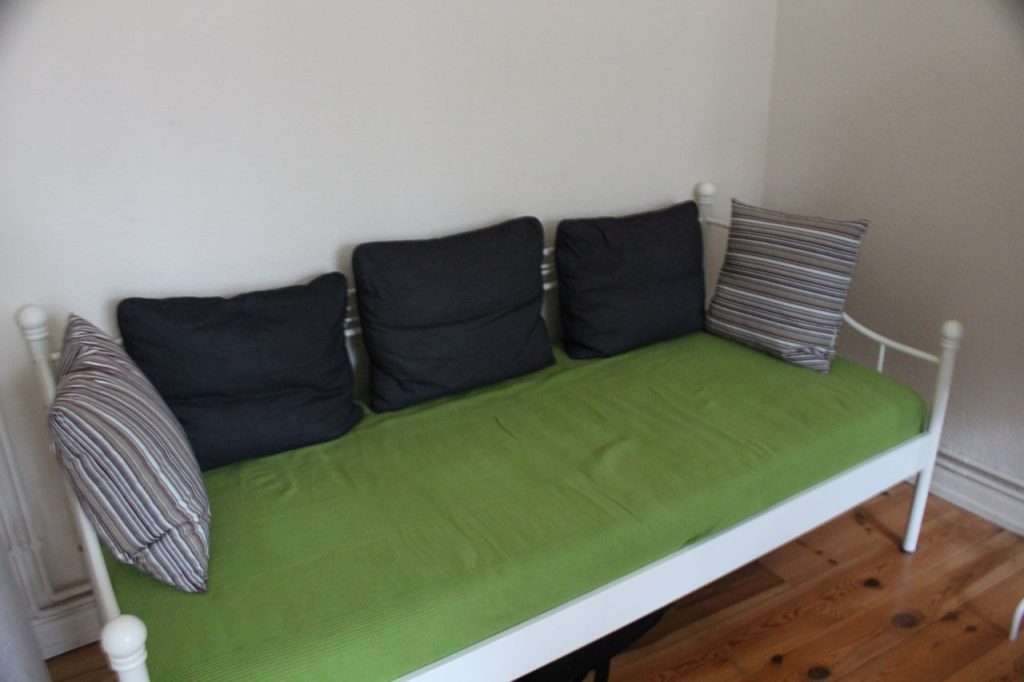That’s typically German: Debit cards and bedding Posted by Sandra Rösner on Feb 10, 2015 in Culture, Traditions
When you visit Germany you will discover that a number of accustomed conditions might differ from your homeland. The first week of February, I spent my holidays in England and there it was easy for me to realize a few standards that are typically German. Payments by debit card and characteristic bedding are just two of them.
Sorry, you are in Germany, we don’t accept credit cards here!
If you would like to pay for your food or your newly chosen gear by credit card it is highly possible that you soon will experience disappointment in Germany. The majority of the local shops, stores, restaurants, and supermarkets just don’t accept credit cards.
When Germans want to pay with plastic money they have to whip out their EC-Karte (ec card; ATM card; debit card). That is, when you pay mit EC-Karte (by ec card) you’re bank account will be immediately debited, whereas your bank account will only be debited once a month when you pay by credit card.
Moreover, very small shops do not accept EC-Karten at all or only when your shopping amounts either to 5 € or even 10 € at the minimum. However, international Hotel- und Handelsketten (hotel and trade chains) as well as many shops in larger cities such as Berlin, Munich, and Hamburg would most likely accept credit cards. If you are not sure how you can pay your expenses just ask. These three sentences will help you with that:
- Akzeptieren Sie Kredikarten? – Do you accept credit cards?
- Kann ich (bei Ihnen) mit Kreditkarte zahlen? – Can I pay by credit card (here)?
- Ab welchen Betrag kann ich (bei Ihnen) mit EC-Karte zahlen? – lit. From which amount can I pay by ec card (at your store)?
Tip: In case you are planning a longer stay in Germany (for example, studying or working here), ask your local bank if they cooperate with a German bank and if they can hand out a debit card, which you can also use in Germany.
You made your bed the German way …
When it comes to sleeping habits there are two significant differences between the Anglo-American and the German culture. Firstly, naming the particular size of a bed. Secondly, the way you use the Bettdecke (duvet) while sleeping.
The English language has a variety of names to denote particular bed sizes: Cot, Single, Small Double or Three Quarter, Double, Queen, King, Super King, etc. The German language, however, is more pragmatic in this way. We don’t have any nice-sounding words for the various bed sizes. We simply specify the sizes of beds, for example, by using either measurements or conventional adjectives such as klein (small) and groß (large).
The ordinary German Matratze (mattress) measures 90 cm (3ft) breadthways and 200 cm (6ft 6″) lengthways. This ordinary mattress is used for a single bed frame – which makes it a Einzelbett (Single). When two of these mattresses are put together they make a Doppelbett (Double) or Ehebett (marriage bed).
Some singles who don’t have to share their bed with another person opt for a bed size, which is larger than the ordinary 90 cm (3ft) by 200 cm (6ft 6″) mattress. Germans refer to this as a großes Einzelbett (large single bed). It’s measures: 140 cm (4ft 6″) by 200 cm (6ft 6″). German couples who think the common lying surface of 180 cm (5ft 9″) by 200 cm (6ft 6″) – two single mattresses put together – is still too small for a restful sleep can also opt for a mattress that measures 200 cm by 200 cm (6ft 6″) or two mattresses that measure 100 cm (3ft 3″) by 200 cm – which makes it ein großes Doppelbett (a large Double).
In order to name a bed made for children, which measures 70 cm (2ft 3″) breadthways and 140 cm (4ft 6″) lengthways, Germans use the term Kinderbett (lit. children’s bed).
To make a long story short: There are several other mattress sizes but none of them has a particular term. In other words, you don’t have to bother with learning news words when it comes to sleeping habits. There is only one thing you must know: The most common standard size for German mattresses is 90 by 200 cm for singles and 180 by 200 cm for couples.
… now sleep in it twisting and turning!
English and American people tend to tuck their duvets under the mattress so that you have to slip in from the top. Germans would hardly acquire a taste for this nighttime covering. We always need a slit in order to let our feet and legs stick out from the duvet, for example, when it’s too warm.
We are also not accustomed to share a duvet with our Ehepartner (spouse) or Lebensgefährte (partner in life). Germans need a duvet to be twisted and turned. This can only be guaranteed when each person has got his or her own duvet for the night. During my stay in England I always pulled out the duvet from under the mattress because it made me feel trapped.
What about you? How do you usually pay expenses in your country? And what does your bed look like?
Vocabulary:
die EC-Karte – ec card
mit EC-Karte bezahlen – to pay by debit card
die Hotelkette – hotel chain
die Handelskette – trade chain
die Bettdecke – duvet
klein – small
groß – large
die Matratze – mattress
das Einzelbett – Single bed
das Doppelbett – Double bed
das Ehebett – marriage bed
das große Einzelbett – the large single bed
das große Doppelbett – the large double bed
das Kinderbett – li. Children’s bed
der Ehepartner – spouse (male)
die Ehepartnerin – spouse (female)
der Lebensgefährte – partner in life (male)
die Lebensgefährtin – partner in life (female)

Build vocabulary, practice pronunciation, and more with Transparent Language Online. Available anytime, anywhere, on any device.
About the Author: Sandra Rösner
Hello everybody! I studied English and American Studies, Communication Science, and Political Science at the University of Greifswald. Since I have been learning English as a second language myself for almost 20 years now I know how difficult it is to learn a language other than your native one. Thus, I am always willing to keep my explanations about German grammar comprehensible and short. Further, I am inclined to encourage you to speak German in every situation. Regards, Sandra






Comments:
Erin:
Ich moechte so zwei Bettdecken fuer meine Mann und ich. Er stielt unsere einzige Bettdecke immer. Nun, unsere Bettdecke ist nicht unter unsere Matratze, nur unsere “top sheet.” Und die deutsche Betten haben kein “top sheet” – es ist immer einfacher so. Mein Sohn steckt seine Bettdecke unter seine Matratze, weil es so fest bleibt. Er mag kalte Fuessen nicht.
So, du hast gesagt, “sprech Deutsch” – ich habe es probiert…
Sandra:
@Erin Very good! I understand everything. 🙂
Tim:
Hello Sandra…in English we pay FOR things. And I never tuck my duvet under the mattress!
T
Sandra:
@Tim Hello Tim,
Thank you for the hint. 🙂
Best regards,
Sandra
Jai Vee:
Wow…informative .. Good to know this bits and pieces.. ThankYou so much.